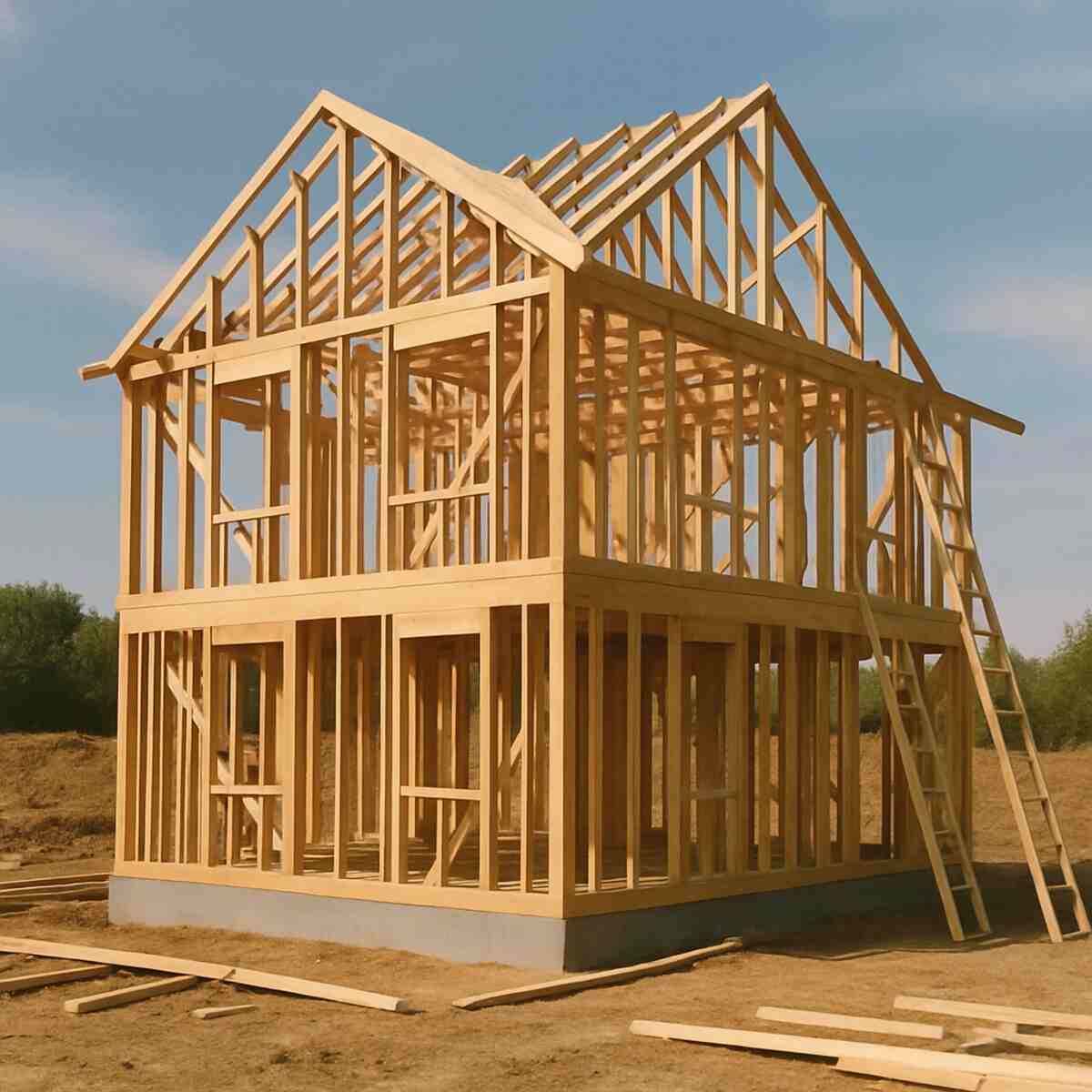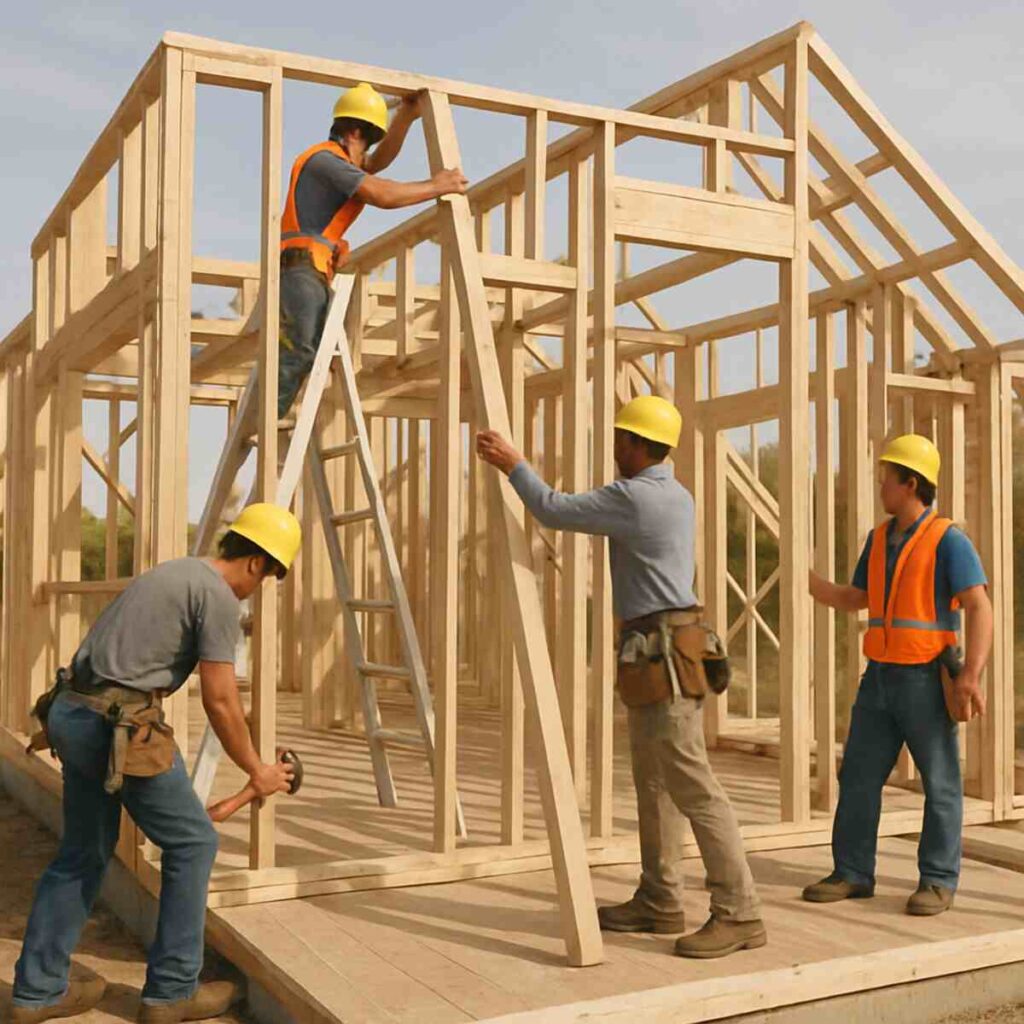
Wood frame houses, also known as timber frame homes, have been a staple in construction for centuries. Their popularity is attributed to their flexibility, cost-effectiveness, and environmental benefits. Let’s explore these advantages in more detail. Best way to find the timber frame house kits.
Versatile Design Possibilities
One of the most significant advantages of building a wooden house is the vast flexibility in design. Wood is an incredibly versatile material, allowing for a wide range of architectural styles-from traditional to modern, rustic to sleek. This versatility means you can customize your home to reflect your personal taste and lifestyle needs. Imagine cozy reading nooks tucked into corners, expansive open-plan living areas that flow seamlessly, or a dedicated study space with a panoramic view of the surroundings. Wood’s adaptability ensures that whatever your design aspirations, they can be realized.
Moreover, wood allows for modifications and expansions with relative ease compared to other building materials. Should your needs evolve over time, adapting your home can be less daunting and more cost-effective. This flexibility is particularly appealing for those who anticipate lifestyle changes, such as growing families or evolving work-from-home requirements.
Cost-Effectiveness
Building with wood can often be more affordable compared to using materials like steel or concrete. The initial costs of materials are typically lower, and the construction process can be completed more quickly, which translates to savings in labor costs. This is excellent news for anyone on a budget, as it allows you to allocate resources to other areas of your home or even save for future needs.
Additionally, wood frame construction often requires fewer specialized tools and machinery, which can further reduce costs. The speed of construction is another financial advantage; a quicker build means less money spent on labor and site management. For many homeowners, these savings can make the dream of owning a custom home more attainable without sacrificing quality or design.
Environmental Benefits
For those conscious of their environmental footprint, wood offers a sustainable building option. Trees absorb carbon dioxide as they grow, and using wood in construction helps to store that carbon, effectively reducing greenhouse gases in the atmosphere. By choosing wood, you are actively contributing to the reduction of carbon emissions-a vital step in combating climate change.
Moreover, wood is a renewable resource that can be sourced from sustainably managed forests. When harvested responsibly, timber production supports biodiversity and forest health. Additionally, wood’s natural insulating properties can lead to energy savings over the life of the home, further minimizing your environmental impact. As awareness of climate issues grows, opting for sustainable building materials like wood becomes an increasingly responsible choice.
Table of Contents
ToggleThe Construction Process: Simple and Efficient

Building a wood-frame house is generally a straightforward and efficient process. Here’s a comprehensive overview to provide a clearer understanding of what to expect during construction:
Step 1: Design and Planning
Before any construction begins, you’ll collaborate with an architect or designer to create a plan that aligns with your needs and desires. Whether you’re envisioning a tranquil writing retreat, a lively family home, or a minimalist loft, the design phase is where your dream begins to take shape. During this stage, you’ll make decisions about the layout, size, and style of your home, ensuring every detail reflects your vision.
The design phase is also the time to consider future needs. Discuss potential expansions, energy efficiency features, and custom elements with your architect. A well-thought-out design can enhance the functionality and longevity of your home, providing a solid foundation for future modifications.
Step 2: Preparing the Site and Laying the Foundation
Once your design is finalized, the construction team will prepare the site and lay the foundation. This crucial step can involve clearing the land, grading the soil, and establishing utilities. The foundation itself can vary based on site conditions and personal preferences, including options like a concrete slab, a crawl space, or a full basement.
The foundation is the most critical structural element of your home, and careful attention must be paid to its construction. A well-laid foundation ensures stability and durability, providing a solid base for the wood frame. Proper site preparation can also prevent future issues such as water drainage problems or soil erosion.
Step 3: Erecting the Frame
This is where the magic begins to happen! The wood frame is erected, forming the skeleton of your home. This stage typically progresses quickly, with walls, floors, and roofs being constructed in rapid succession. It’s an exciting time as you watch your home take shape right before your eyes.
Framing is a pivotal stage in construction, as it defines the structure and layout of your home. The precision and quality of the framing work will have a lasting impact on the overall integrity of the house. Skilled craftsmen ensure that every joint and beam is securely connected, providing a sturdy framework for the rest of the build.
Step 4: Enclosure and Weatherproofing
With the frame in place, the next step is to enclose the home with walls, roofing, and windows. This stage transforms the skeletal structure into a protected space, safeguarding it from the elements. Proper weatherproofing is essential to ensure the longevity and energy efficiency of the home.
The enclosure process involves installing insulation, vapor barriers, and exterior finishes. These components work together to create a comfortable indoor environment, regardless of the weather outside. Attention to detail in this phase can lead to significant energy savings and increased comfort levels throughout the year.
Step 5: Interior Finishes and Customization
Finally, the interior of your home is finished to your specifications. This phase includes everything from installing insulation and drywall to laying flooring and fitting fixtures. It’s the stage where your personal style and preferences come to life, transforming the construction site into a livable space.
Interior finishes offer an opportunity to infuse your personality into the home. Choose materials, colors, and layouts that reflect your taste and meet your practical needs. From sleek modern kitchens to rustic wood-paneled living rooms, the choices are endless. Before you know it, you’ll be decorating your new wood frame house and making it uniquely yours.
Living in a Wood Frame House
Living in a wood frame house comes with a unique set of perks. Here are a few things to look forward to:
Natural Insulation and Energy Efficiency
Wood is a natural insulator, which means it helps keep your home warm in the winter and cool in the summer. This thermal efficiency can lead to significant energy savings and a more comfortable living environment year-round. The insulating properties of wood contribute to a consistent indoor temperature, reducing the reliance on heating and cooling systems.
Energy efficiency in wood frame homes is further enhanced by modern construction techniques and materials. Properly installed insulation, energy-efficient windows, and well-sealed doors work together to minimize heat loss and gain. This not only saves on utility bills but also reduces your home’s carbon footprint, making it an environmentally friendly living choice.
Aesthetic Appeal and Personalization
There’s something undeniably charming about wood. It adds warmth and character to any home, making it feel inviting and cozy. Whether you opt for exposed beams, hardwood floors, or wood paneling, you’ll love the natural beauty that wood brings to your living space. The aesthetic appeal of wood is timeless, offering a classic look that can be adapted to suit any interior design style.
Wood’s versatility allows for endless customization options. You can choose from a variety of wood types, finishes, and stains to achieve the exact look you desire. Whether you’re aiming for a rustic cabin feel or a sleek modern aesthetic, wood can be tailored to meet your design vision. This level of personalization ensures that your home is a true reflection of your tastes and lifestyle.
Durability, Longevity, and Maintenance
When properly maintained, a wood frame house can last for generations. Regular maintenance, such as painting, sealing, and checking for pests, will keep your home in excellent condition for years to come. With the right care, wood can withstand the test of time, providing a durable and reliable structure for your family.
Maintenance is an essential aspect of preserving the beauty and functionality of a wood frame home. Routine inspections and timely repairs can prevent minor issues from becoming major problems. By staying proactive with maintenance tasks, you ensure that your home remains a safe and comfortable haven for years to come.
Tips for Maintaining Your Wood Frame House
To get the most out of your timber frame home, regular maintenance is key. Here are some tips to keep your home in top shape:
Regular Inspections and Repairs
Conduct regular inspections to check for any signs of damage, such as rot, warping, or pest infestations. Addressing issues promptly can prevent them from worsening and protect the structural integrity of your home. Pay particular attention to areas exposed to the elements, such as windows, doors, and the roof.
Routine maintenance tasks, such as cleaning gutters and checking for leaks, can prevent water damage and extend the life of your home. By staying vigilant and addressing issues early, you can avoid costly repairs down the line.
Sealing and Protecting Wood Surfaces
Protect your wood from moisture by sealing it regularly. This helps prevent rot and extends the life of the wood. Use high-quality sealants and finishes to create a barrier against water, UV rays, and other environmental factors. Regularly sealing wood surfaces not only protects them but also enhances their natural beauty.
In addition to sealing, consider using wood treatments that repel pests and inhibit mold growth. These treatments can provide an extra layer of protection, ensuring that your home remains in pristine condition.
Managing Moisture and Ventilation
Ensure that your home is well-ventilated to prevent moisture build-up, which can lead to mold and mildew. Proper ventilation is crucial in areas like kitchens, bathrooms, and basements, where humidity levels are higher. Use exhaust fans, dehumidifiers, and proper ventilation systems to maintain a healthy indoor environment.
Monitoring humidity levels and maintaining adequate airflow can prevent moisture-related issues and contribute to the overall comfort of your home. By managing moisture effectively, you protect your investment and promote a healthy living space.
Updating and Refreshing Aesthetic Features
Keep your home updated with regular painting or staining to maintain its aesthetic appeal and protect the wood. Over time, exposure to the elements can cause finishes to fade or degrade. Refreshing your home’s appearance with a fresh coat of paint or stain can rejuvenate its look and provide an additional layer of protection.
Updating aesthetic features also allows you to keep up with design trends and make your home feel new again. Whether you’re changing color schemes or adding new design elements, regular updates ensure that your home continues to reflect your style.
Conclusion
Building a wood frame house offers a range of benefits, from design flexibility and cost-effectiveness to sustainability and natural beauty. Whether you’re looking to create a cozy retreat for writing, a functional space for work, or a peaceful environment for study, a timber frame home can meet your needs and provide a comfortable, inviting living space for years to come. So why not consider wood for your next home project? It might just be the perfect fit for you! Embrace the timeless elegance and sustainable advantages of wood and transform your dream home into a reality.
